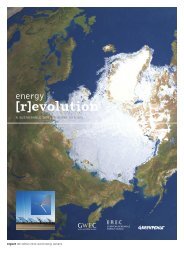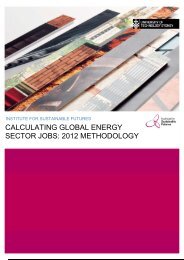download the mexico energy revolution scenario
download the mexico energy revolution scenario
download the mexico energy revolution scenario
Create successful ePaper yourself
Turn your PDF publications into a flip-book with our unique Google optimized e-Paper software.
image GREENPEACE OPENS A SOLAR<br />
ENERGY WORKSHOP IN BOMA. A MOBILE<br />
PHONE GETS CHARGED BY A SOLAR<br />
ENERGY POWERED CHARGER.<br />
© GP/PHILIP REYNAERS<br />
Within <strong>the</strong> next ten years, <strong>the</strong> power sector will decide how this new<br />
demand will be met, ei<strong>the</strong>r by fossil and nuclear fuels or by <strong>the</strong><br />
efficient use of renewable <strong>energy</strong>. The Energy [R]evolution <strong>scenario</strong><br />
is based on a new political framework in favour of renewable<br />
<strong>energy</strong> and cogeneration combined with <strong>energy</strong> efficiency.<br />
To make this happen both renewable <strong>energy</strong> and cogeneration – on<br />
a large scale and through decentralised, smaller units – have to<br />
grow faster than overall global <strong>energy</strong> demand. Both approaches<br />
must replace old generating technologies and deliver <strong>the</strong> additional<br />
<strong>energy</strong> required in <strong>the</strong> developing world.<br />
As it is not possible to switch directly from <strong>the</strong> current large scale<br />
fossil and nuclear fuel based <strong>energy</strong> system to a full renewable<br />
<strong>energy</strong> supply, a transition phase is required to build up <strong>the</strong><br />
necessary infrastructure. Whilst remaining firmly committed to <strong>the</strong><br />
promotion of renewable sources of <strong>energy</strong>, we appreciate that gas,<br />
used in appropriately scaled cogeneration plants, is valuable as a<br />
transition fuel, and able to drive cost-effective decentralisation of<br />
<strong>the</strong> <strong>energy</strong> infrastructure. With warmer summers, tri-generation,<br />
which incorporates heat-fired absorption chillers to deliver cooling<br />
capacity in addition to heat and power, will become a particularly<br />
valuable means of achieving emissions reductions.<br />
a development pathway<br />
The Energy [R]evolution envisages a development pathway which<br />
turns <strong>the</strong> present <strong>energy</strong> supply structure into a sustainable system.<br />
There are three main stages to this.<br />
step 1: <strong>energy</strong> efficiency<br />
The Energy [R]evolution is aimed at <strong>the</strong> ambitious exploitation of<br />
<strong>the</strong> potential for <strong>energy</strong> efficiency. It focuses on current best<br />
practice and technologies that will become available in <strong>the</strong> future,<br />
assuming continuous innovation. The <strong>energy</strong> savings are fairly<br />
equally distributed over <strong>the</strong> three sectors – industry, transport and<br />
domestic/business. Intelligent use, not abstinence, is <strong>the</strong> basic<br />
philosophy for future <strong>energy</strong> conservation.<br />
The most important <strong>energy</strong> saving options are improved heat<br />
insulation and building design, super efficient electrical machines and<br />
drives, replacement of old style electrical heating systems by<br />
renewable heat production (such as solar collectors) and a reduction<br />
in <strong>energy</strong> consumption by vehicles used for goods and passenger<br />
traffic. Industrialised countries, which currently use <strong>energy</strong> in <strong>the</strong> most<br />
inefficient way, can reduce <strong>the</strong>ir consumption drastically without <strong>the</strong><br />
loss of ei<strong>the</strong>r housing comfort or information and entertainment<br />
electronics. The Energy [R]evolution <strong>scenario</strong> uses <strong>energy</strong> saved in<br />
OECD countries as a compensation for <strong>the</strong> increasing power<br />
requirements in developing countries. The ultimate goal is stabilisation<br />
of global <strong>energy</strong> consumption within <strong>the</strong> next two decades. At <strong>the</strong><br />
same time <strong>the</strong> aim is to create ‘<strong>energy</strong> equity’ – shifting <strong>the</strong> current<br />
one-sided waste of <strong>energy</strong> in <strong>the</strong> industrialised countries towards a<br />
fairer worldwide distribution of efficiently used supply.<br />
A dramatic reduction in primary <strong>energy</strong> demand compared to <strong>the</strong><br />
IEA’s Reference <strong>scenario</strong> (see chapter 6) – but with <strong>the</strong> same GDP<br />
and population development - is a crucial prerequisite for achieving<br />
a significant share of renewable <strong>energy</strong> sources in <strong>the</strong> overall <strong>energy</strong><br />
supply system, compensating for <strong>the</strong> phasing out of nuclear <strong>energy</strong><br />
and reducing <strong>the</strong> consumption of fossil fuels.<br />
step 2: <strong>the</strong> renewable <strong>energy</strong> [r]evolution<br />
decentralised <strong>energy</strong> and large scale renewables In order to<br />
achieve higher fuel efficiencies and reduce distribution losses, <strong>the</strong><br />
Energy [R]evolution <strong>scenario</strong> makes extensive use of Decentralised<br />
Energy (DE).This is <strong>energy</strong> generated at or near <strong>the</strong> point of use.<br />
DE is connected to a local distribution network system, supplying<br />
homes and offices, ra<strong>the</strong>r than <strong>the</strong> high voltage transmission<br />
system. The proximity of electricity generating plant to consumers<br />
allows any waste heat from combustion processes to be piped to<br />
nearby buildings, a system known as cogeneration or combined heat<br />
and power. This means that nearly all <strong>the</strong> input <strong>energy</strong> is put to use,<br />
not just a fraction as with traditional centralised fossil fuel plant.<br />
4<br />
<strong>the</strong> <strong>energy</strong> [r]evolution | A DEVELOPMENT PATHWAY<br />
figure 4.1: centralised <strong>energy</strong> infrastructures waste more than two thirds of <strong>the</strong>ir <strong>energy</strong><br />
61.5 units<br />
LOST THROUGH INEFFICIENT<br />
GENERATION AND HEAT WASTAGE<br />
3.5 units<br />
LOST THROUGH TRANSMISSION<br />
AND DISTRIBUTION<br />
13 units<br />
WASTED THROUGH<br />
INEFFICIENT END USE<br />
© DREAMSTIME<br />
© DREAMSTIME<br />
100 units >><br />
ENERGY WITHIN FOSSIL FUEL<br />
38.5 units >><br />
OF ENERGY FED TO NATIONAL GRID<br />
35 units >><br />
OF ENERGY SUPPLIED<br />
22 units<br />
OF ENERGY<br />
ACTUALLY UTILISED<br />
37



![Energy [R]evolution - European Commission](https://img.yumpu.com/49109324/1/184x260/energy-revolution-european-commission.jpg?quality=85)


![5905 gp [eu rev]csfr4.qxd - Energy [R]evolution](https://img.yumpu.com/42305023/1/184x260/5905-gp-eu-revcsfr4qxd-energy-revolution.jpg?quality=85)


![5905 gp [eu rev]csfr4.qxd - Energy [R]evolution](https://img.yumpu.com/28729264/1/184x260/5905-gp-eu-revcsfr4qxd-energy-revolution.jpg?quality=85)